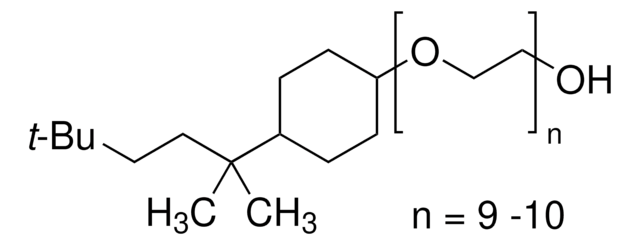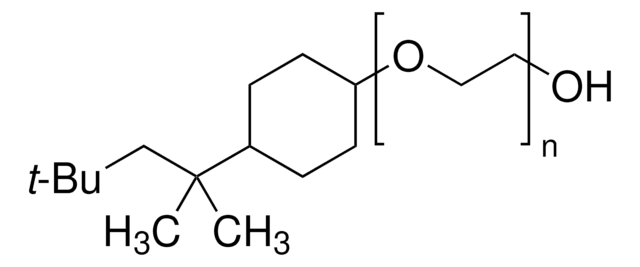X100RS
Triton™ X-100 reduced
Synonyme(s) :
Polyoxyethylene (10) isooctylcyclohexyl ether
About This Item
Produits recommandés
Source biologique
synthetic (oragnic)
Niveau de qualité
Description
non-ionic
Forme
viscous liquid
Poids mol.
micellar average mol wt 80,000
average mol wt 625
Nombre d'agrégation
100-155
Indice de réfraction
n20/D 1.473 (lit.)
CMC
0.2-0.9
Pf
48 -50 °C (118 - 122 °F)
Température de transition
cloud point 65 °C
Solubilité
water: soluble, clear to slightly hazy, colorless
Densité
1.029 g/mL at 25 °C (lit.)
Absorption
≤0.25 at 277 nm in H2O at 0.5%
HLB
13.5
Chaîne SMILES
CC(C)(C)CC(C)(C)C1CCC(CC1)OCCOCCOCCOCCOCCOCCOCCO
InChI
1S/C28H56O8/c1-27(2,3)24-28(4,5)25-6-8-26(9-7-25)36-23-22-35-21-20-34-19-18-33-17-16-32-15-14-31-13-12-30-11-10-29/h25-26,29H,6-24H2,1-5H3
Clé InChI
QQJNBKDKLMCALZ-UHFFFAOYSA-N
Vous recherchez des produits similaires ? Visite Guide de comparaison des produits
Catégories apparentées
Description générale
In cell biology, Triton™ X-100 plays a crucial role in solubilizing membrane-bound proteins, preserving their native conformation in solution. Furthermore, Triton™ X-100 reduced, resulting from the full hydrogenation of the benzene moiety of TX-100 to a cyclohexane derivative, has been associated with potential benefits in enzyme digestion enhancement and effects on the photoisomerization of bacteriorhodopsin. The versatility of Triton™ X-100 in various research applications underscores its significance as a fundamental tool in biochemical and cell biology investigations.
Application
- in nuclear magnetic resonance (NMR) sample tube for lysing/rupturing the 1,2-dipalmitoyl-sn-glycero-3-phosphocholine (DPPC) phospholipid vesicles
- in cell permeabilization
- as a component in Tris/HCl to determine hydrolysis of the esters for enzyme activity assays
Caractéristiques et avantages
- Non-ionic surfactant
- Improves solubility and dispersibility of substances
- Excellent wetting properties
- Enhances emulsification
- High purity product for research applications
Notes préparatoires
Autres remarques
Informations légales
Produit comparable
Mention d'avertissement
Warning
Mentions de danger
Conseils de prudence
Classification des risques
Aquatic Chronic 2 - Eye Irrit. 2 - Skin Irrit. 2 - STOT SE 3
Organes cibles
Respiratory system
Code de la classe de stockage
10 - Combustible liquids
Classe de danger pour l'eau (WGK)
WGK 3
Point d'éclair (°F)
235.4 °F - closed cup
Point d'éclair (°C)
113 °C - closed cup
Équipement de protection individuelle
dust mask type N95 (US), Eyeshields, Gloves
Faites votre choix parmi les versions les plus récentes :
Déjà en possession de ce produit ?
Retrouvez la documentation relative aux produits que vous avez récemment achetés dans la Bibliothèque de documents.
Les clients ont également consulté
Notre équipe de scientifiques dispose d'une expérience dans tous les secteurs de la recherche, notamment en sciences de la vie, science des matériaux, synthèse chimique, chromatographie, analyse et dans de nombreux autres domaines..
Contacter notre Service technique






